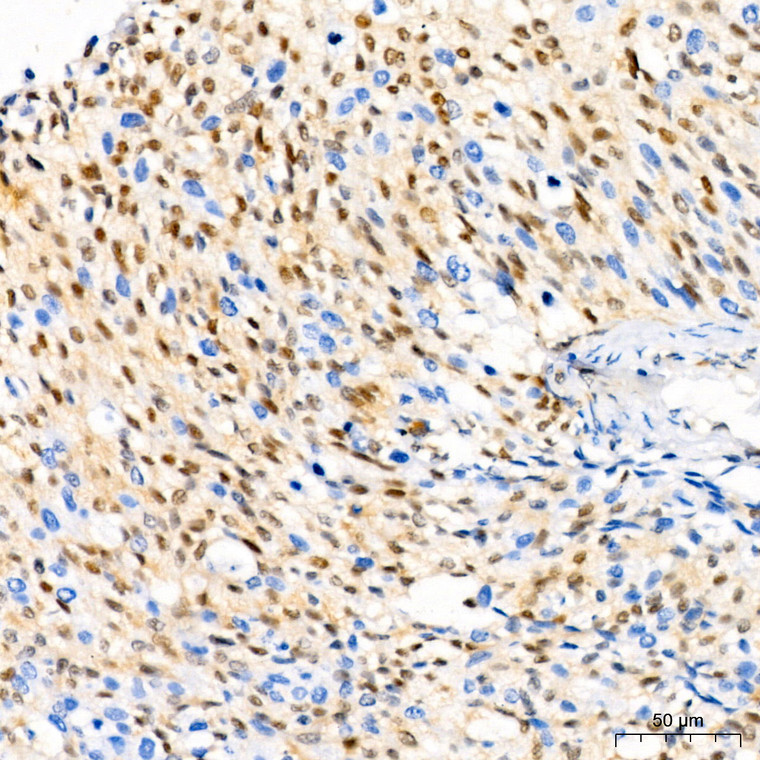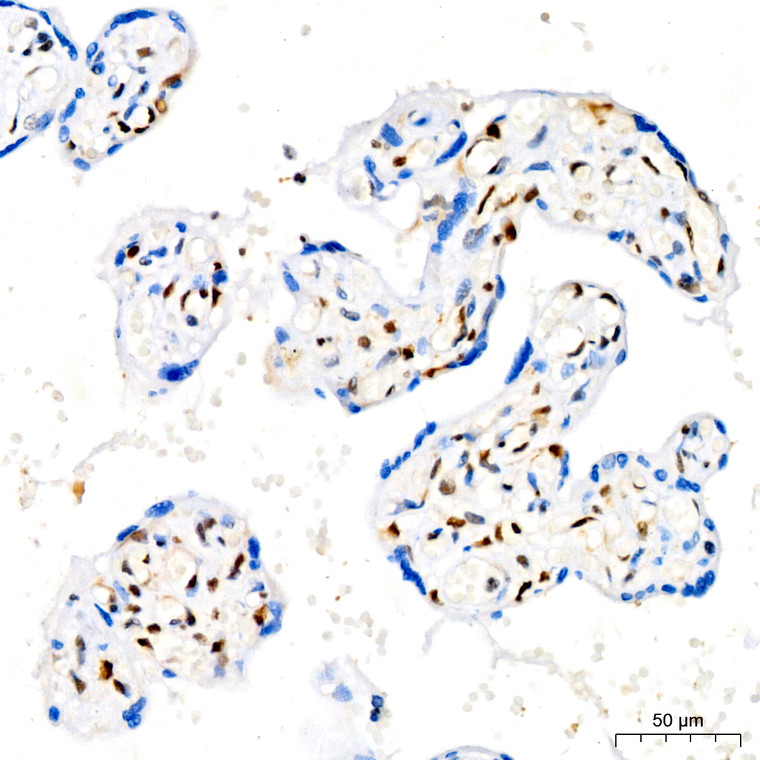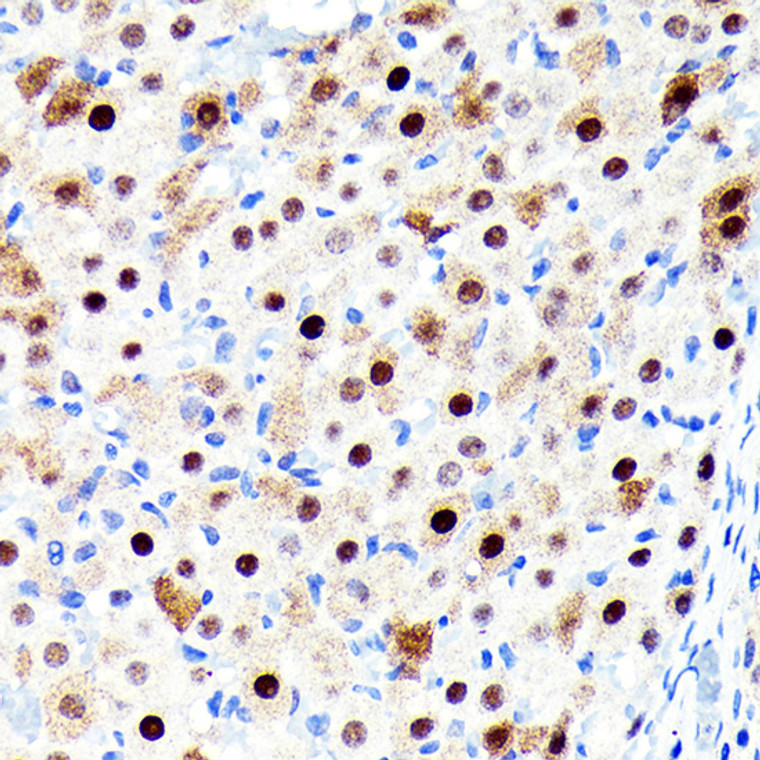| Host: |
Rabbit |
| Applications: |
WB/IHC |
| Reactivity: |
Human/Mouse/Rat |
| Note: |
STRICTLY FOR FURTHER SCIENTIFIC RESEARCH USE ONLY (RUO). MUST NOT TO BE USED IN DIAGNOSTIC OR THERAPEUTIC APPLICATIONS. |
| Short Description: |
Rabbit monoclonal antibody anti-CDKN1B/p27KIP1 (99-198) is suitable for use in Western Blot and Immunohistochemistry research applications. |
| Clonality: |
Monoclonal |
| Clone ID: |
S2MR |
| Conjugation: |
Unconjugated |
| Isotype: |
IgG |
| Formulation: |
PBS with 0.02% Sodium Azide, 0.05% BSA, 50% Glycerol, pH7.3. |
| Purification: |
Affinity purification |
| Dilution Range: |
WB 1:500-1:1000IHC-P 1:50-1:200 |
| Storage Instruction: |
Store at-20°C for up to 1 year from the date of receipt, and avoid repeat freeze-thaw cycles. |
| Gene Symbol: |
CDKN1B |
| Gene ID: |
1027 |
| Uniprot ID: |
CDN1B_HUMAN |
| Immunogen Region: |
99-198 |
| Immunogen: |
A synthetic peptide corresponding to a sequence within amino acids 99-198 of human CDKN1B/p27KIP1 (P46527). |
| Immunogen Sequence: |
CKVPAQESQDVSGSRPAAPL IGAPANSEDTHLVDPKTDPS DSQTGLAEQCAGIRKRPATD DSSTQNKRANRTEENVSDGS PNAGSVEQTPKKPGLRRRQT |
| Tissue Specificity | Expressed in kidney (at protein level). Expressed in all tissues tested. Highest levels in skeletal muscle, lowest in liver and kidney. |
| Post Translational Modifications | Phosphorylated.phosphorylation occurs on serine, threonine and tyrosine residues. Phosphorylation on Ser-10 is the major site of phosphorylation in resting cells, takes place at the G(0)-G(1) phase and leads to protein stability. Phosphorylation on other sites is greatly enhanced by mitogens, growth factors, cMYC and in certain cancer cell lines. The phosphorylated form found in the cytoplasm is inactivate. Phosphorylation on Thr-198 is required for interaction with 14-3-3 proteins. Phosphorylation on Thr-187, by CDK1 and CDK2 leads to protein ubiquitination and proteasomal degradation. Tyrosine phosphorylation promotes this process. Phosphorylation by PKB/AKT1 can be suppressed by LY294002, an inhibitor of the catalytic subunit of PI3K. Phosphorylation on Tyr-88 and Tyr-89 has no effect on binding CDK2, but is required for binding CDK4. Dephosphorylated on tyrosine residues by G-CSF. Ubiquitinated.in the cytoplasm by the KPC complex (composed of RNF123/KPC1 and UBAC1/KPC2) and, in the nucleus, by SCF(SKP2). The latter requires prior phosphorylation on Thr-187. Ubiquitinated.by a TRIM21-containing SCF(SKP2)-like complex.leads to its degradation. Subject to degradation in the lysosome. Interaction with SNX6 promotes lysosomal degradation. |
| Function | Important regulator of cell cycle progression. Inhibits the kinase activity of CDK2 bound to cyclin A, but has little inhibitory activity on CDK2 bound to SPDYA. Involved in G1 arrest. Potent inhibitor of cyclin E- and cyclin A-CDK2 complexes. Forms a complex with cyclin type D-CDK4 complexes and is involved in the assembly, stability, and modulation of CCND1-CDK4 complex activation. Acts either as an inhibitor or an activator of cyclin type D-CDK4 complexes depending on its phosphorylation state and/or stoichometry. |
| Protein Name | Cyclin-Dependent Kinase Inhibitor 1bCyclin-Dependent Kinase Inhibitor P27P27kip1 |
| Database Links | Reactome: R-HSA-187577Reactome: R-HSA-198323Reactome: R-HSA-2559582Reactome: R-HSA-2559586Reactome: R-HSA-5625900Reactome: R-HSA-5674400Reactome: R-HSA-6804116Reactome: R-HSA-69202Reactome: R-HSA-69231Reactome: R-HSA-69563Reactome: R-HSA-69656Reactome: R-HSA-8849470Reactome: R-HSA-9607240Reactome: R-HSA-9617828Reactome: R-HSA-9634638Reactome: R-HSA-9661069 |
| Cellular Localisation | NucleusCytoplasmEndosomeNuclear And Cytoplasmic In Quiescent CellsAkt- Or Rsk-Mediated Phosphorylation On Thr-198Binds 14-3-3Translocates To The Cytoplasm And Promotes Cell Cycle ProgressionMitogen-Activated Uhmk1 Phosphorylation On Ser-10 Also Results In Translocation To The Cytoplasm And Cell Cycle ProgressionPhosphorylation On Ser-10 Facilitates Nuclear ExportTranslocates To The Nucleus On Phosphorylation Of Tyr-88 And Tyr-89Colocalizes At The Endosome With Snx6This Leads To Lysosomal Degradation |
| Alternative Antibody Names | Anti-Cyclin-Dependent Kinase Inhibitor 1b antibodyAnti-Cyclin-Dependent Kinase Inhibitor P27 antibodyAnti-P27kip1 antibodyAnti-CDKN1B antibodyAnti-KIP1 antibodyAnti-p27 antibody |
Information sourced from Uniprot.org
12 months for antibodies. 6 months for ELISA Kits. Please see website T&Cs for further guidance
















